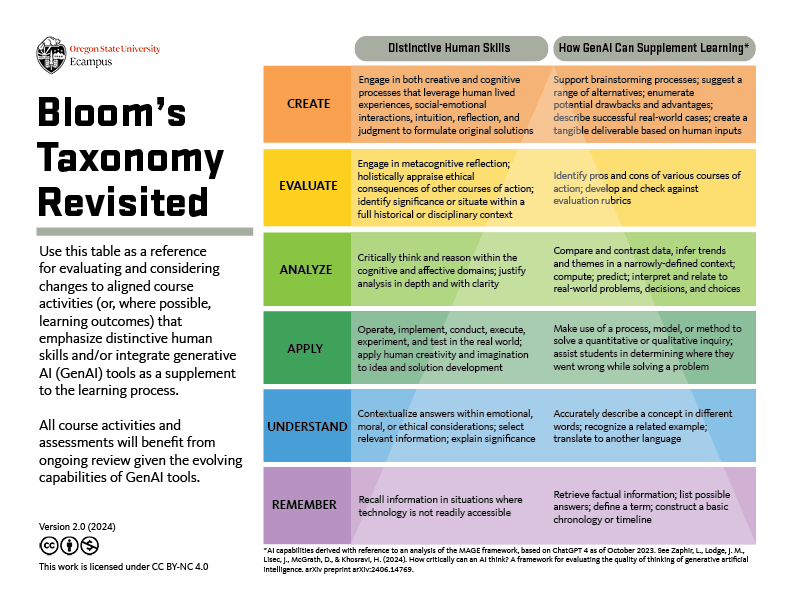Faculty support
Experts in online course design
Work one-on-one with an instructional designer to build and bring your course online.
Artificial Intelligence Tools
Advancing meaningful learning in the age of AI
Bloom’s Taxonomy is often used as a resource to help higher education faculty assess what kinds or “levels” of learning are planned based on course-level outcomes and, relatedly, to align appropriate activities and assessments to support student learning and success. Here, we have used Bloom’s Taxonomy as a touchstone for reconsidering course outcomes and student learning in the age of generative artificial intelligence (GenAI). This resource is intended for faculty and instructional designers to use as a guide to reflect on activities, assessments, and (possibly) course outcomes. One goal for such reflection is to identify what changes may be needed to ensure meaningful learning going forward and possible opportunities for thoughtful integration of student use of GenAI.
We also encourage faculty and instructional designers to consider the student perspective in learning design. For recommendations offered by OSU students through an in-depth survey about AI use and perceptions, see Student Perceptions of Generative AI tools in Online Courses: Recommendations for Faculty; a full report of the survey results is also available.
Download PDF
Bloom's Taxonomy Revisited – in a printable table format
Use this table as a reference for evaluating and considering changes to aligned course activities (or, where possible, learning outcomes) that emphasize distinctive human skills and/or integrate generative AI (GenAI) tools as a supplement to the learning process.
All course activities and assessments will benefit from ongoing review given the evolving capabilities of GenAI tools.
Version 2.0 (2024)
This work is licensed under CC BY-NC 4.0
|
|
Distinctive Human Skills |
How GenAI Can Supplement Learning Processes+ |
|---|---|---|
|
Create |
Engage in both creative and cognitive processes that leverage human lived experiences, social-emotional interactions, intuition, reflection, and judgment to formulate original solutions. |
Support brainstorming processes; suggest a range of alternatives; enumerate potential drawbacks and advantages; describe successful real-world cases; create a tangible deliverable based on human inputs |
|
Evaluate |
Engage in metacognitive reflection; holistically appraise ethical consequences of alternative courses of action; identify significance or situate within a full historical or disciplinary context |
Identify pros and cons of various courses of action; develop and check against evaluation rubrics |
|
Analyze |
Critically think and reason within the cognitive and affective domains; justify analysis in depth and with clarity |
Compare and contrast data, infer trends and themes in a narrowly-defined context; compute; predict; interpret and relate to real-world problems, decisions, and choices |
|
Apply |
Operate, implement, conduct, execute, experiment, and test in the real world; apply human creativity and imagination to idea and solution development |
Make use of a process, model, or method to solve a quantitative or qualitative inquiry; assist students in determining where they went wrong while solving a problem |
|
Understand |
Contextualize answers within emotional, moral, or ethical considerations; select relevant information; explain significance |
Accurately describe a concept in different words; recognize a related example; translate to another language |
|
Remember |
Recall information in situations where technology is not readily accessible |
Retrieve factual information; list possible answers; define a term; construct a basic chronology or timeline |
+ AI capabilities derived with reference to an analysis of the MAGE framework across multiple disciplines, based on ChatGPT 4 as of October 2023. See Zaphir, L., Lodge, J. M., Lisec, J., McGrath, D., & Khosravi, H. (2024). How critically can an AI think? A framework for evaluating the quality of thinking of generative artificial intelligence. arXiv preprint arXiv:2406.14769.
Download accessible DOCX
Creative Commons license
This work created by Oregon State University Ecampus is licensed under Creative Commons Attribution-NonCommercial 4.0 International (CC BY-NC 4.0).
Features and Navigation
Ready for fall term?
Faculty resources: CRN request, update syllabus, order textbooks, schedule exam proctoring, course rollover. See checklist.
We offer financial support to develop and refresh online programs and courses. Submit a course proposal or a new program proposal.


